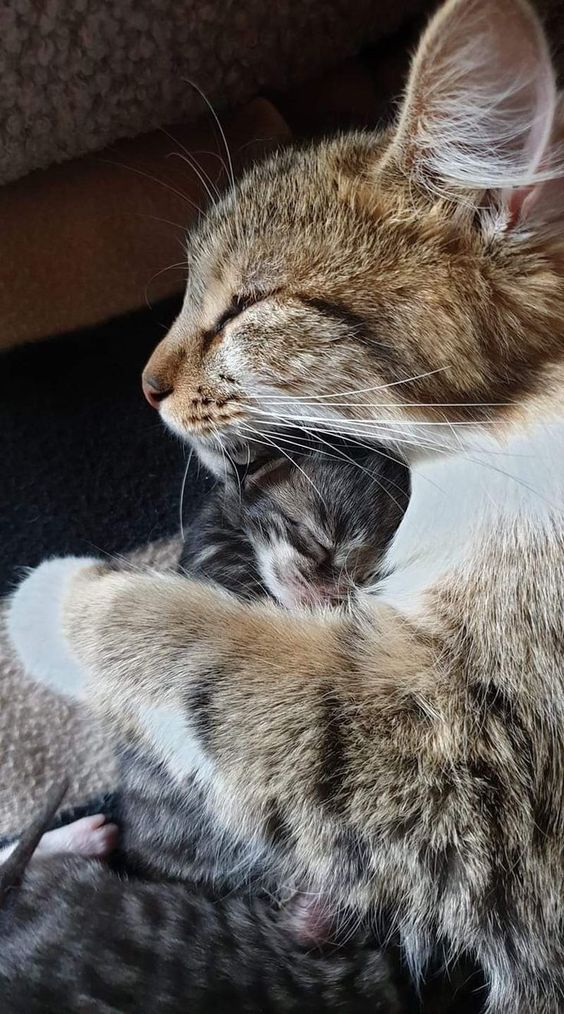
Cats have been human companions for centuries, admired for their independence, grace, and enigmatic nature. Beyond their individual charm, the dynamics within cat families offer a fascinating glimpse into their social structures and behaviors. This article explores the captivating world of feline families, from kittenhood to the complex interactions in both wild and domestic settings.
The Early Days: Birth and Kittenhood
The life of a cat family begins with the birth of kittens, a time marked by rapid development and maternal care:
- Newborn Kittens: Kittens are born blind and deaf, relying completely on their mother for warmth, nutrition, and protection. During these initial weeks, the mother cat, or queen, devotes herself to nursing and grooming her young, ensuring their safety and well-being.
- First Milestones: Around two weeks of age, kittens open their eyes and ears, starting to explore their immediate environment. This period is crucial for sensory development and bonding with their mother and littermates.

Development and Socialization
As kittens grow, they begin to develop social skills and physical abilities:
- Exploration and Play: By three to four weeks, kittens start to explore beyond their nest, engaging in playful activities that are essential for learning hunting skills and social behaviors. Play-fighting with siblings helps them practice coordination and build strength.
- Weaning: At around six to eight weeks, kittens begin transitioning from their mother’s milk to solid food, marking a significant step towards independence. Despite this, they may continue to nurse occasionally for comfort and additional nutrition.
The Role of Male Cats

In the wild, the involvement of male cats, or toms, varies significantly:
- Protective Fathers: In some cases, toms may protect the queen and kittens from predators and rival males, though direct involvement in raising the kittens is rare.
- Independent Lives: Typically, toms do not participate in the upbringing of their offspring, leaving the queen to handle all parental duties.
Feral Cat Colonies: Social Structure and Behavior
Feral cat colonies provide insight into the natural social structures of cats:
- Matriarchal Groups: These colonies often consist of related females and their offspring, with the oldest and most experienced female leading the group.
- Cooperative Care: Within these colonies, queens may help each other by nursing and grooming each other’s kittens, creating a supportive environment that enhances the survival of the young.
- Territorial Behavior: Cats establish and defend territories through scent markings and vocalizations, maintaining a structured social order within the colony.
Communication and Interaction
Communication plays a vital role in maintaining the bonds within cat families:
- Vocalizations: Cats use a variety of sounds, including meows, purrs, hisses, and growls, to convey different messages and emotions to their family members.
- Body Language: Tail movements, ear positions, and overall posture are significant indicators of a cat’s mood and intentions.
- Scent Marking: Cats have scent glands on their faces, paws, and tails, which they use to mark their territory and identify each other, reinforcing social bonds within the family.
Domestic Cat Families
In domestic settings, the dynamics between cat family members and humans add another layer of complexity:
- Human Bonding: Domestic cats often form strong attachments to their human caretakers, showing affection through purring, head-butting, and following them around the house.
- Socialization and Training: Early interaction with humans and other pets helps kittens grow into well-adjusted adults. Positive experiences during kittenhood are crucial for their development.
- Environmental Enrichment: Providing toys, scratching posts, and safe spaces for exploration keeps domestic cats mentally and physically stimulated, promoting overall well-being.
Responsibilities of Cat Ownership
Caring for a cat family involves numerous responsibilities:
- Health Care: Regular veterinary check-ups, vaccinations, and spaying or neutering are essential for preventing diseases and managing the cat population.
- Nutrition: A balanced diet is crucial for the health and growth of both kittens and adult cats.
- Safe Living Conditions: Ensuring a safe, clean, and stimulating environment is vital for the well-being of cats, whether they live indoors or have access to controlled outdoor spaces.
The intriguing dynamics of cat families reveal a world of nurturing care, social learning, and complex interactions. By understanding and appreciating these behaviors, we can deepen our bond with these captivating creatures and ensure their health and happiness. Whether in the wild or as cherished members of our homes, cat families continue to enchant and fascinate us with their unique blend of independence and affection.


